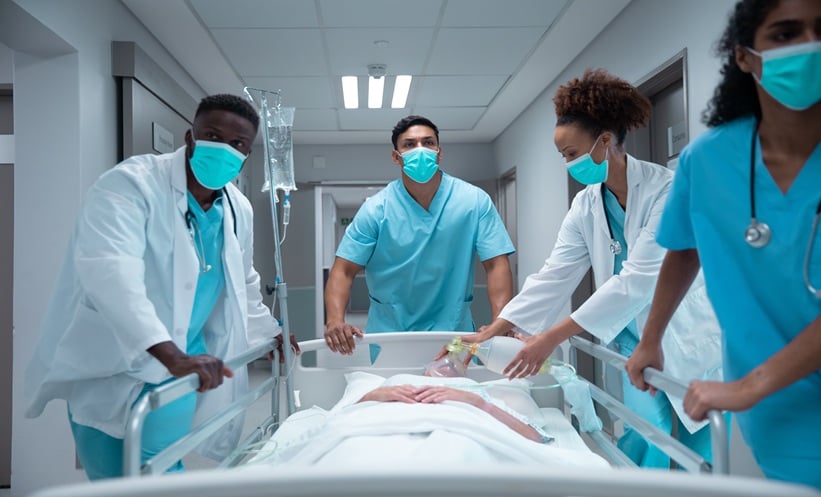Author:Laith Gergi, EMJ, London, UK
Citation: EMJ Microbiol Infect Dis. 2024;5[1]:26-29. https://doi.org/10.33590/emjmicrobiolinfectdis/ZATI1178.
![]()
BIOLOGICAL THERAPIES IN MODERN MEDICINE
Isabel Ruiz-Camps, University Hospital Vall d’Hebron, Barcelona, Spain, commenced the session by discussing the role of biologic therapies in patients who are immunocompromised. The use of biologic therapies or ‘biologicals’ has transformed the treatment landscape and outcomes for a myriad of diseases, including solid cancers, haematological malignancies, rheumatoid arthritis, and inflammatory bowel disease. Biologicals encompass monoclonal antibodies, receptor analogues, and chimeric small molecules, often targeting specific receptors, cytokines, or cell types, directly or indirectly intervening in immunological pathways, to modulate innate and adaptive immune responses. Ruiz-Camps noted how biologic agents are increasingly used daily due to their potency advantages and reduced side effects. However, Ruiz-Camps called to attention the association between the application of biologicals and infectious complications, especially in patients with a history of autoimmune and inflammatory diseases. She stated that this association represents a significant hurdle in their safe implementation. Therefore, a nuanced understanding of the factors that govern infection risk with biologicals is required to improve patient outcomes.
RISK PROFILE OF PATIENTS
Ruiz-Camps discussed that the risk of infectious complications in patients who are immunocompromised, and receiving biologicals, is dynamic. The risks fluctuate over the patient’s lifetime, and are influenced by three key factors: specific treatment regimen, underlying disease, and host health status. While biologicals may lead to an increased risk of infection to all microorganism origins, specific infection risk is affected by the cytokine receptor, or immune cell targeted for inhibition. For example, there is a well-established relationship between infliximab, a chimeric monoclonal antibody targeting TNF, and the reactivation of latent tuberculosis. Nevertheless, Ruiz-Camps emphasised the significance of host factors in infection risk. She expanded on this by discussing a study examining the infection risk in patients with juvenile idiopathic arthritis from a prospective, observational registry receiving different biologic therapies.1 The study’s main findings were that relative to TNFα inhibitors, IL-1 inhibitors and IL-6 inhibitors had a higher impact on increasing infection risk.1 However, the most striking risk factors for infectious complications were the use of corticosteroids, younger age, cardiac comorbidities, and lack of disease control in the host. Accordingly, a similar study evaluating the risk of infection in patients with inflammatory bowel disease found that other than the type of biologic agent, the most consistent risk factors for opportunistic infection included advanced age, severe disease activity, and use of corticosteroids.2
PREVENTION METHODS OF INFECTIOUS COMPLICATIONS
Although there is a growing understanding of infection risk factors associated with biologic agents, Ruiz-Camps highlighted the absence of universal standards for prevention methods. Therefore, to implement prophylaxis treatments, it is essential to fully understand the immunological effect of a biologic agent and relevant host factors; hence, a complete clinical history should be carried out. For a patient undergoing treatment, Ruiz-Camps listed personal comorbidities, history, place of origin, travels, sexual behaviour, contact with pets, and pharmacological history as important details of personal history to be collected. Additionally, vaccination and screening for patients are essential, and proactive prevention strategies should ideally be performed before the start of the treatment. Some adverse events mimic infection; therefore, if an infection is suspected, accurate and aggressive diagnosis is required to prevent severe infection.
Ruiz-Camps explained that infection is frequent in patients who are immunocompromised and undergoing treatment with biologicals, and the risk is dependent on the specific biologic therapy, underlying disease, and host health status. Comprehensive risk assessment, proactive prophylaxis treatment, timely diagnosis, and as always, antimicrobial stewardship are required to optimise patient outcomes.
CELLULAR THERAPIES FOR IMMUNOCOMPROMISED DIFFICULT-TO-TREAT INFECTIONS
In the second talk of the session, Nina Khanna, University Hospital Basel, Switzerland, introduced the potential of cellular therapies, specifically virus-specific T cell therapy (VST), in strengthening the immune response in patients who are immunocompromised. Khanna emphasised that the number of patients who are immunosuppressed is increasing, and due to impaired immunity, these patients are at a high risk of viral infections. Allogeneic haematopoietic stem cell (HSCT) and solid organ transplant recipients have a high incidence of double-stranded DNA viral infections in the immune-deficient post-transplant period. Infectious complications represent a leading cause of death and morbidity in HSCT and solid organ transplant recipients. Typically, patients with infectious complications will be treated with anti-infectives; however, because of ongoing immune deficiency, patients have a high risk of persistence and resistance development. Hence, Khanna indicated that the best approach is employing cell-based therapy to strengthen and improve immunity.
ADOPTIVE VIRUS-SPECIFIC T CELL THERAPY
Khanna explained how virus-specific T cells can be obtained from partially HLA-matched seropositive donors. Following this, peripheral blood mononuclear cells are extracted, stimulated with viral antigens, and specific cells are isolated and expanded. Infusion of VST into allogeneic haematopoietic stem cells and solid organ transplant recipients allows the reconstitution of antiviral immunity, as there is self-renewal of this new T cell repertoire, providing host protection. However, Khanna pointed out some of the challenges in VST application, including a lack of indications for when VST is recommended, and that use is based mainly on Phase I/II trial data. Additionally, for stem cell transplant recipients, the best donor for T cells is the stem cell donor in HSCT, but the donor is not always eligible because they are seronegative.
EFFICACY AND SAFETY OF VST
Discussing the outcomes of over 1,500 patients who have so far received VST post-HSCT, Khanna explained that based on data from all studies, 70% of these patients experienced either partial or complete resolution of symptoms, while the risk for graft-versus-host disease remained low, at around 10%. Furthermore, in a Swiss-wide Phase I/II trial initiated in 2015 to treat refractory virus infection with VST, 14 patients were treated; seven with cytomegalovirus and seven with Epstein–Barr virus (EBV).3 The outcome was similar to the literature, with 85% and 57% partial/complete resolution for cytomegalovirus and EBV, respectively.3
Khanna discussed an open-label Phase II trial evaluating the safety outcomes of posoleucel, an allogenic, off-the-shelf multi-virus-specific T cell therapy, used to treat refractory viral infection in transplant recipients.4 The study included 58 patients with persistent or recurrent infection despite 14 days of standard treatment, or after treatment failure after 7 days.4 Patients received an intervention of a single infusion of VST. Results showed partial/complete resolution in 95% of patients, increased immunological response, and clinical safety within tolerable levels with 22% acute graft-versus-host disease.4 Moreover, another VST immunotherapy called tabelecleucel was approved by the European Medicines Agency (EMA) in 2023, for adults and children from 2 years of age with EBV-positive post-transplant lymphoproliferative disorder. These studies serve as evidence for, and provide support to, the utilisation of VST in clinical settings.
CHALLENGES AND OUTLOOKS
Although promising data are emerging regarding using VST to protect stem cell and solid organ transplant recipients, Khanna stressed that the problem of impaired long-term persistence, due to an immune suppressive microenvironment and ongoing systemic immune suppression, compromises VST. Increased T cell exhaustion and impaired functional capacity of T cells are often observed in treated patients. In addition, the rejection of infused cells often means that serial VST infusions are required in clinical settings. Therefore, with these challenges in mind, Khanna’s research group investigated whether T cell exhaustion can be countered by utilising early differentiated T cells.
Early differentiated T cells show high proliferation and self-renewable capacity. Khanna’s group pursued a hypothesis exploring whether enrichment of VST product with early differentiated T cells could induce higher persistence and longevity. A rapid expansion protocol was used to generate a new immunotherapy product to test this. The Khanna group tested the product on immunodeficient mice infected with EBV. The mice were treated after 3 days with the traditional VST product, and the newly generated T cell product. Both therapies showed similar macroscopic tumour control, but the rapid protocol T cells demonstrated higher proliferation and persistence capacity, and lower residual tumour cells. Hence, VST enriched for early-differentiated therapy may represent the future of virus-specific cell therapy.
CONCLUDING REMARKS
VST is an emerging immunotherapy for immunocompromised difficult-to-treat infections, with increasing evidence supporting the introduction of VST in clinics. However, Khanna underscored how unanswered questions regarding the optimal indication and timing of the T cell product for treatment needed to be addressed.
Khanna concluded her presentation by highlighting novel immune therapeutics for immunocompromised patients, such as soluble T cell receptors acting as antibody-like agents, and genetically modified T cells used for individuals without suitable T cell donors.
A common theme throughout the session revolved around the challenges and opportunities introduced by the new age of biologic therapies. While promising data continue to accumulate, demonstrating the potential of biologicals in transforming patient outcomes, continued research evaluating how doses or specific applications can be optimised to confer effectivity while minimising complications is needed.







